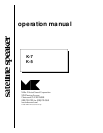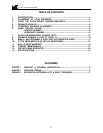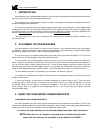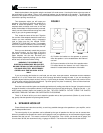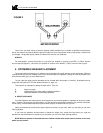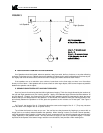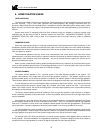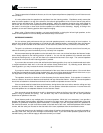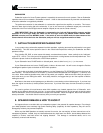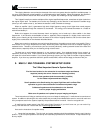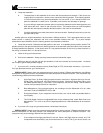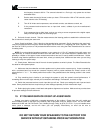
There is a great deal of latitude in this area, as it is one of personal preference (especially if you will listen to music
without video).
It is also preferred that the speakers be equidistant from the listening position. Equidistant usually means that
when the center speaker is on top of the television, the left and right speakers will sit in front of the set (they will be
farther from the wall behind the TV than the center speaker). Ideally, the speakers should be at the same height as
the screen, but it is much more important that all three speakers be at as close to each other's height as possible. If
the center is much higher or lower than the other speakers, the effect can be distracting. Angling, or toeing-in the
speakers, to aim at the listening position often improves imaging.
When using a Center channel speaker, you have extra flexibility in placing the left and right speakers, as the
Center channel speaker will tie most dialog and effects directly to the screen.
SURROUND CHANNELS
You can achieve good performance with your surround speakers placed in a wide variety of room locations. In
general, they should be either adjacent to or behind the main listening position, located higher than the listeners’
heads. They can be mounted on the side walls or on the back wall, flush to the wall, on shelves, on brackets, etc.
The goal is to achieve an enveloping sound. The surround channels should seem to come from all around you,
rather than seeming to come from behind you only or directly from a speaker.
We recommend starting with speakers on the side walls of the room, two to three feet above the listeners' heads,
either directly adjacent to the listening position or behind it. You can aim the speakers to fire towards each other
(across the listening area), or you can aim them to fire towards the back wall at an angle. The surround speakers
should not be in front of the main listening position if possible.
If you mount the surrounds on the side wall behind the listening position, they can be aimed towards each other
or angled towards the back wall or the side wall surface directly behind them. By reflecting sound behind the
listening position, you may increase the sense of envelopment in the sound.
If you want or need to mount speakers on the back wall of the room, there are several options. You can aim them
so that they fire towards each other (along the back wall); you can aim them towards the front wall of the room; or you
can angle them so they fire toward the side walls. Symmetrical arrangements work best.
The speakers should be a minimum of a few feet away from the nearest listener. If the speaker is located too
close to a listener, its sound can become too directional and may distract that listener. Ideally, the surround speakers
should not call attention to themselves and should not be audible as separate sources of sound.
If the surrounds must be located close to the listeners, aiming them at the room walls or even the ceiling can help
to reduce any directional effect. As described above, this can produce a desirable result even in rooms where the
surround speakers are an adequate distance from the listeners' heads.
If the surrounds cannot be placed on a wall, try placement on tables or the floor to the sides of the main listening
position, firing up towards the ceiling. This can work very well in environments that do not allow permanent
attachment of speakers to the walls.
Some listeners prefer to use multiple pairs of surround speakers. While this is not necessary, it can provide a
broader and deeper surround effect, with better coverage in very large rooms. When using multiple pairs of surround
speakers, a symmetrical installation pattern works best. For example, if you are using two pairs of K-5 speakers for
the surround channels, one pair could be mounted on the back wall of the room, mounted equidistant from the back
corners, with the other pair mounted on the side walls of the room, equidistant from the same back corners.
The surround channels can be installed in a wide variety of locations, but because they are usually mounted on
the walls of the room, they can be a challenge to successfully install. If you have further questions, please call us at
the M&K factory, and we will be happy to discuss them with you in detail.
9
K-5/K-7 SATELLITESPEAKER



